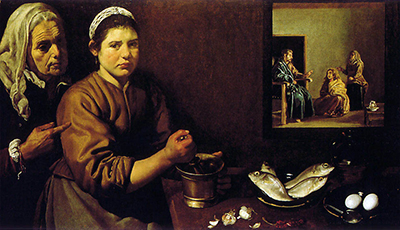This well-crafted painting was actually produced by Diego Velazquez whilst he was still in his late teens, underlining the extraordinary rate of progress that he achieved in the early stages of his career.
Christ in the House of Martha and Mary offers us a clever composition that essentially places two different paintings together on the same canvas. We first have the foreground double portrait, with a second set of content being included on the wall of their room. The food being prepared on the table to the right hand side also gives us an early look into Velazquez's skills within the genre of still life. There we find a selection of fish, with some eggs and also some other items for the purposes of seasoning and flavouring this simple meal. Perhaps some of the facial features of the two figures nearest us are not quite as refined as his later portraits, but it is still a sublime and exciting piece that must have raised eyebrows at the time because of the unusual layout. Velazquez would become one of the finest portrait painters that the world has ever seen, but his early pieces were bolder and more risky, where he felt perhaps a greater sense of freedom.
The image on the wall is so clear that you first wonder if it is actually a painting within a painting, but actually it is more likely the reflection of a mirror, displaying what is happening on the other side of the room. This also matches the title of the work, suggesting that Christ is sat down behind the viewer, whilst we focus on the two women who are preparing food to mark his visit. This would be a relatively small artwork, at just over half a metre in height, and is currently part of the collection of the National Gallery in London, UK. We do know that the artist was interested in the genre known as bodegones during this time, where life inside taverns and domestic locations would capture the lives of ordinary folk. This provides us with a visual understanding of how people would go about their daily lives, but later in his career Velazquez would switch to the rich and famous of Spanish society, including members of their royal family.
Visitors to the National Gallery will find a number of other paintings by this artist, most of which are single portraits which was the genre which dominates his oeuvre. There are several portraits of Philip IV of Spain which also provide historical value to many, as well as a number of religious-based items, such as The Immaculate Conception and Christ contemplated by the Christian Soul. The Toilet of Venus ('The Rokeby Venus') is perhaps the best known of all to be found here, and also related to Christ in the House of Martha and Mary because it also uses a mirror as a means to offer content using innovative layout techniques. The institution may not be able to compete with the Prado for their coverage of Velazquez, but few other institutions can compete as well as this one.




